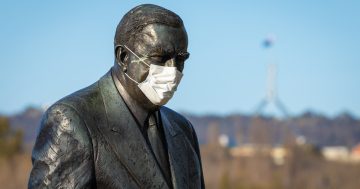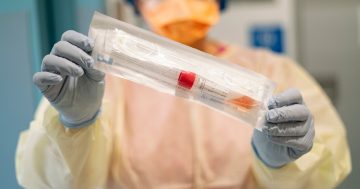
CHS CEO Dave Peffer: scenarios “give us a level of confidence we aren’t too far from seeing a peak”. Photo: Michelle Kroll.
There is cautious optimism that the ACT’s Omicron-driven COVID-19 surge may be close to peaking, with new internal Canberra Health Services modelling showing the current outbreak may subside sooner than expected.
In an email sent to hospital staff yesterday (11 January) and sighted by Region Media, CHS CEO Dave Peffer outlines three scenarios. The most likely one has new cases peaking on 17 January and the number of COVID patients in hospital peaking three days later on 20 January.
Health officials had believed that the ACT was a few weeks behind NSW, where the Omicron outbreak is tipped to peak in mid-January, although some believe it may have already done so.
But now the modelling, used to plan for hospital capacity, points to the current outbreak giving way before the end of the month, and the number of people in hospital peaking at just under 100, four times the current load but manageable without resorting to activating the Garran Surge Centre, according to hospital sources.
Today there are 23 patients in hospital with COVID, down from 28 yesterday, but the figures are expected to jump around.
The best-case scenario has new cases peaking yesterday (11 January) and hospitalisations three days later, while the worst-case has cases peaking on 21 January and hospitalisations on 27 January.
Both of these are considered possible but unlikely.
Mr Peffer warns there are unknown factors such as the level of underreporting that may upset the modelling, but the scenarios suggest there is light at the end of the tunnel for stretched hospital staff, struggling businesses and the Canberra community.
“They’re based on data we have at this point, the experiences we’re seeing locally and overseas, and give us a level of confidence we aren’t too far from seeing a peak in cases and hospitalisations,” he said.
According to sources, CHS modelling has been quite accurate so far.
Mr Peffer told staff that managing the workload will be tough going, but the recent changes to patient cohorting will help.
“Our planning for this potential demand won’t stop – we’ll continue to make changes within our health services on a daily (and sometimes hourly) basis, to sustainably respond to the patients we see presenting,” he said.

A Rapid Antigen Test. Results can now be submitted online as the ACT transitions to this form of testing. Photo: File.
The issue of underreporting should be resolved with the announcement today that people will be able to notify their Rapid Antigen Test results online as part of a transition to that form of testing.
Chief Minister Andrew Barr said a Check In CBR push notification would be sent today to users to let them know a reporting form on the ACT COVID-19 website is now live.
He said the change would provide more accurate data, better connect people with care and ease the pressure on testing centre queues as RATs become more available.
“We are working to secure a greater supply of tests for the ACT, including the purchase of one million test kits in partnership with NSW and our own orders,” Mr Barr said.
Acting Health Minister Chris Steel said the ACT would not be following NSW’s move to hit people with $1000 fines if they fail to report their RAT results.
He said those who have already had taken a rapid test should submit their results to ACT Health.
The government was still working on how to distribute RATs, but Mr Steel said some would be handed out at testing centres.
A sign of the increasing pressures on the health system was today’s announcement that the Central Health Intake (CHI) phone line used to book some services at community health centres and outpatient clinics will be closed temporarily from tomorrow (13 January).
CHS says the change is temporary so staff can be redeployed to support the team caring for people recovering at home with the virus.
Nurses will only be available to process urgent referrals from GPs, and people are being advised to speak to their GP if an urgent referral is needed, or cancel an appointment online.
Like many sectors, the health system is managing the challenge of staff falling ill or needing to isolate.




















